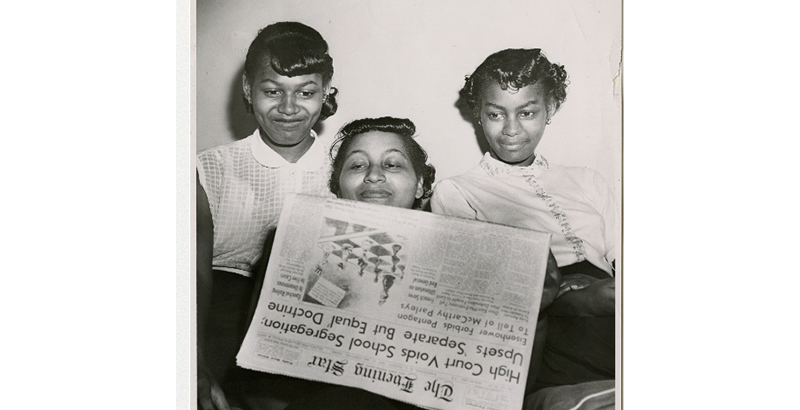Brown v. Board at 65 — Adrienne Jennings Bennett on the Anticipation & Anxiety That Followed the Verdict: How Soon Would D.C. Implement School Desegregation?

This testimonial is an excerpt from Recovering Untold Stories: An Enduring Legacy of the Brown v. Board of Education Decision, a new book spotlighting the original plaintiffs behind five pivotal school segregation lawsuits later consolidated by the Supreme Court. Read more first-person accounts, watch oral histories, learn more about the cases and download the book at The74Million.org/Brown65
Monday, Sept. 11, 1950, was a regularly scheduled school day within the D.C. public school system. However, on this day, I did not attend Randall Junior High School, which was my current school in the southwest section of D.C. Rather, on this school day, I anxiously assembled with a group of students and parents at the Campbell A.M.E. Church to ready ourselves to travel to John Philip Sousa Junior High School in hopes of gaining admission to attend this newly built segregated “whites only” school in Washington, D.C., which was in my neighborhood of Anacostia. We gathered in a caravan of cars and proceeded to travel to the new school.
While riding to the school, I was anxiously anticipating what would happen once we arrived and what my first day would be like at the new school. Although I was looking forward to attending the new school, I was having some reservation because I wanted to stay at my current school with my long-standing classmates. Nevertheless, I was excited, carrying my new notebook and other new school supplies.
Once we arrived at the school, I assembled in line with the other students and parents behind Mr. Gardner Bishop, the president of the Consolidated Parents Group, who escorted us to the front entrance of the school. The school principal greeted us at the school’s front entrance and informed us that we would not be admitted. We then peacefully returned to our cars and traveled back to our homes.
It was of no surprise that our request for admission was rejected. Our civil act to seek admission through our trip to John Philip Sousa Junior High School served as our “test case” to desegregate schools, which aided in our legal quest to end the “Separate but Equal” doctrine.
Now that I was not granted admission to attend John Philip Sousa Junior High School, I was eager to return to my current school and continue my learning experience in an environment where the teachers were devoted to educating and “growing” African-American students.
The day of the decision
It was Monday, May 17, 1954. I arrived at Spingarn High School, located in the northeast section of Washington, D.C., for a typical school day. While sitting in my French class in the early afternoon, listening to the instructions of my teacher, Mrs. Valerie Parks, I heard a voice echoing from the school’s public address system. The voice announced that the U.S. Supreme Court had rendered its decision concerning the Brown v. Board of Education case. We won the case! Classes have ended for the day!
I quickly gathered my belongings, as did other students, and proceeded to leave the school building. The school’s hallways were filled with voices of excitement and celebration from the victorious outcome of the case.
While walking down the hill from the school to the bus stop, I was approached by a reporter, who startled me by rudely placing his microphone directly in my face, forcefully asking me about my reaction to the decision. Before I could respond, my bus arrived, and I quickly ran to board the bus.
As I sat on the bus, many passengers were excitedly discussing the outcome of the case. I, too, was excited and couldn’t wait to get home to celebrate with my parents. However, I was thinking about how soon the D.C. schools would implement desegregation. This concerned me because I was in the 11th grade, and like many teenagers, my friendships with my classmates were very important to me. My desire was to remain at my current school to graduate with my fellow classmates in the event that desegregation would be implemented before my graduation. Would the desegregation date be effective before or after my high school graduation? That was the question. I didn’t know if I would have an option to remain at my current school.
Once I arrived at home, my mom greeted me and said that this was a great day for D.C.! She mentioned that reporters would be stopping by to conduct interviews and to take pictures. Throughout the evening, as I was working to complete my homework assignments, my parents continued to share their excitement with family and friends. This was indeed a great day for the District of Columbia!
Adrienne Jennings Bennett is the daughter of James C. Jennings, a plaintiff in Washington, D.C.’s Bolling v. Sharpe that was later consolidated as part of the Brown v. Board Supreme Court case.
This testimonial is an excerpt from Recovering Untold Stories: An Enduring Legacy of the Brown v. Board of Education Decision, a new book spotlighting the original plaintiffs behind five pivotal school segregation lawsuits later consolidated by the Supreme Court. Read more first-person accounts, watch oral histories, learn more about the cases and download the book at The74Million.org/Brown65
Disclosure: The Walton Family Foundation provides financial support to The 74 and funded The Brown Foundation for Educational Equity, Excellence and Research to produce the new book Recovering Untold Stories: An Enduring Legacy of the Brown v. Board of Education Decision.
Get stories like these delivered straight to your inbox. Sign up for The 74 Newsletter

;)